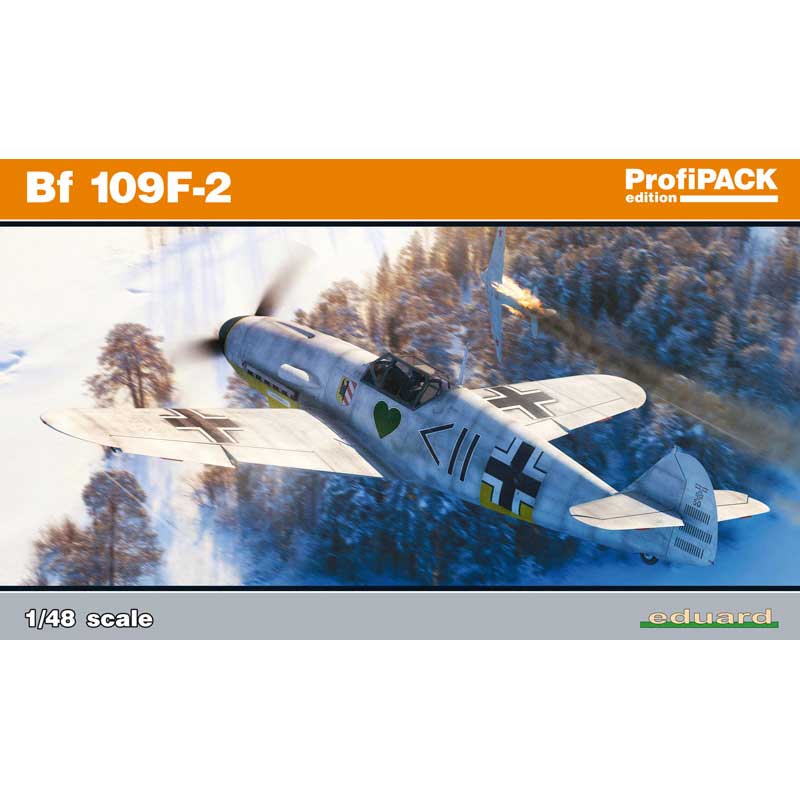1/48 Profipack – Bf 109F-2 Eduard 82115
The Bf 109A was the first version of the Bf 109. Armament was initially planned to be just two cowl-mounted 7.92 mm (.312 in) MG 17 machine guns. However, possibly due to the introduction of the Hurricane and Spitfire, each with eight 7.7 mm (.303 in) machine guns, experiments were carried out with a third machine gun firing through the propeller shaft. V4 and some A-0 were powered by a 640 PS (631 hp, 471 kW) Junkers Jumo 210B engine driving a two-blade fixed-pitch propeller, but production was changed to the 670 PS (661 hp, 493 kW) Jumo 210D as soon as it became available. The A-0 was not of a uniform type; there were several changes in their appearance. Visible changes included engine, cockpit and machine gun ventilation holes/slats, and the location of the oil cooler was changed several times to prevent overheating. Many of these Bf 109 A-0 served with the Legion Condor and were often misidentified as B-series aircraft, and probably served in Spain with the tactical markings 6-1 to 6–16. One A-0, marked as 6–15, ran out of fuel and was forced to land behind enemy lines. It was captured by Republican troops on 11 November 1937 and later transferred to the Soviet Union for a closer inspection.[3] 6–15 incorporated several improvements from the Bf 109B production program and had been prepared to use a variable-pitch propeller although it had not been installed.
As the DB 601 E was not yet available in numbers, the pre-production F-0 (the only F variant to have a rectangular supercharger intake) and the first production series F-1/F-2 received the 1,175 PS (1,159 hp, 864 kW) DB 601N engine driving a VDM 9-11207 propeller.[36] The F-0/F-1 and F-2 only differed in their armament; the F-1 being fitted with one 20 mm MG FF/M Motorkanone firing through the propeller hub, with 60 rounds. The F-1 first saw action in the Battle of Britain in October 1940 with JG 51.[48] The most experienced fighter aces like Werner Mölders were the first ones to fly Bf 109 F-1s in combat in October 1940.[46] A total of 208 F-1s were built between August 1940 and February 1941 by Messerschmitt Regensburg and the Wiener Neustädter Flugzeugwerke (WNF).
The F-2 introduced the 15 mm Mauser MG 151 cannon with 200 rounds.] As the harder-hitting 20 mm Mauser MG 151/20 version became available, a number of F-2s were retrofitted with it in the field. About 1,230 F-2s were built between October 1940 and August 1941 by AGO, Arado, Erla, Messerschmitt Regensburg and WNF(Wiener Neustädter Flugzeugwerke). No tropical version was built, although F-2s were fitted with sand filters in the field.[51] The maximum speed of the F-1 and F-2 was 615 km/h (382 mph) at rated altitude.
F-0 (Pre-production aircraft built from E series airframes, Adolf Galland was one of the few to fly one operationally)
F-1 (Armed with 1 × 20 mm MG FF/M Motorkanone cannon and 2 × 7.92 mm/.312 in MG 17 machine guns)
F-2 (Armed with 1 × 15 mm (.59 in) MG 151 cannon and 2 × 7.92 mm/.312 in MG 17)
F-2 trop (tropicalized version, only as field conversion)
F-2/Z (high-altitude fighter with GM-1 boost, cancelled in favour of the F-4/Z)


